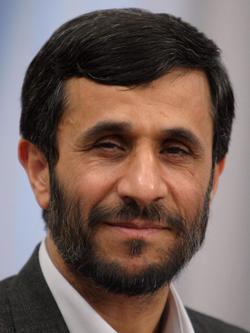
158 cm
Mahmoud Ahmadinejad (Persian: محمود احمدینژاد, romanized: Mahmūd Ahmadīnežād, pronounced [mæhmuːd(e) æhmædiːneʒɒːd] ; born Mahmoud Sabbaghian [محمود صباغیان, Mahmūd Sabbāghiyān] on 28 October 1956) is an Iranian principlist and nationalist politician who served as the sixth president of Iran from 2005 to 2013. He is currently a member of the Expediency Discernment Council. He was known for his hardline views and nuclearisation of Iran. He was also the main political leader of the Alliance of Builders of Islamic Iran, a coalition of conservative political groups in the country, and served as mayor of Tehran from 2003 to 2005, reversing many of his predecessor's reforms.
An engineer and teacher from a poor background, he was ideologically shaped by thinkers such as Navvab Safavi, Jalal Al-e-Ahmad, and Ahmad Fardid. After the Iranian Revolution, Ahmadinejad joined the Office for Strengthening Unity. Appointed a provincial governor in 1993, he was replaced along with all other provincial governors in 1997 after the election of President Mohammad Khatami and returned to teaching. Tehran's council elected him mayor in 2003. He took a religious hard line, reversing reforms of previous moderate mayors. His 2005 presidential campaign, supported by the Alliance of Builders of Islamic Iran, garnered 62% of the runoff election votes, and he became president on 3 August 2005.
During his presidency, Ahmadinejad was a controversial figure both in Iran and worldwide. He was criticized domestically for his economic policies, and was accused of disregard for human rights by organizations in North America and Europe. Outside of Iran, he was criticized for his hostility towards countries including Israel, Saudi Arabia, the United Kingdom, and the United States and other Western and Arab states. In 2007, Ahmadinejad introduced a gasoline rationing plan to reduce the country's fuel consumption and cut the interest rates that private and public banking facilities could charge. He supports Iran's nuclear program. His election to a second term in 2009 was widely disputed, and led to widespread protests domestically and criticism from Western countries.
During his second term, Ahmadinejad experienced a power struggle with reformers and other traditionalists in Parliament and the Revolutionary Guard, as well as with Supreme Leader Ali Khamenei, over his dismissal of intelligence minister Gholam-Hossein Mohseni-Eje'i and his support for his controversial close adviser, Esfandiar Rahim Mashaei. On 14 March 2012, Ahmadinejad became the first president of the Islamic Republic of Iran to be summoned by the Islamic Consultative Assembly (parliament) to answer questions regarding his presidency. Limited to two terms under the current Iranian constitution, Ahmadinejad supported Mashaei's campaign for president. In 2013, Hassan Rouhani was elected as Ahmadinejad's successor.
On 12 April 2017, Ahmadinejad announced that he intended to run for a third term in the 2017 presidential election, against the objections of Supreme Leader Khamenei. His nomination was rejected by the Guardian Council. During the 2017–18 Iranian protests, Ahmadinejad criticized the current government of Iran. He made a second attempt at registering to run for the 2021 presidential election, and was rejected again by the Guardian Council. He registered as a candidate in the 2024 Iranian presidential election, but was subsequently rejected.
Source : Wikipedia